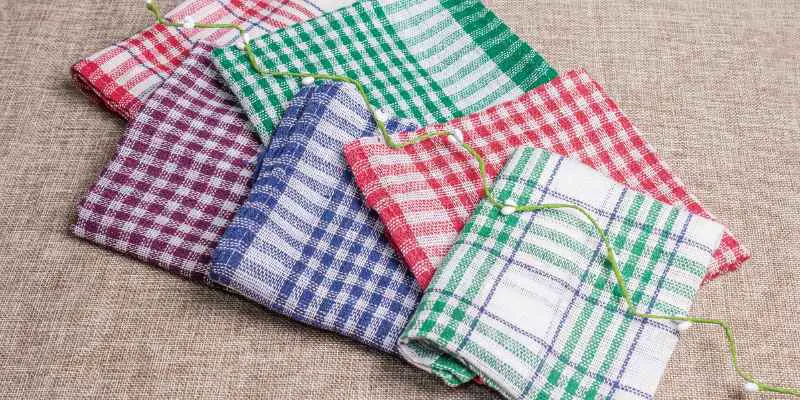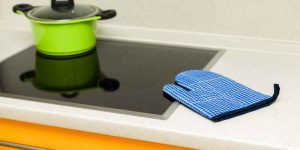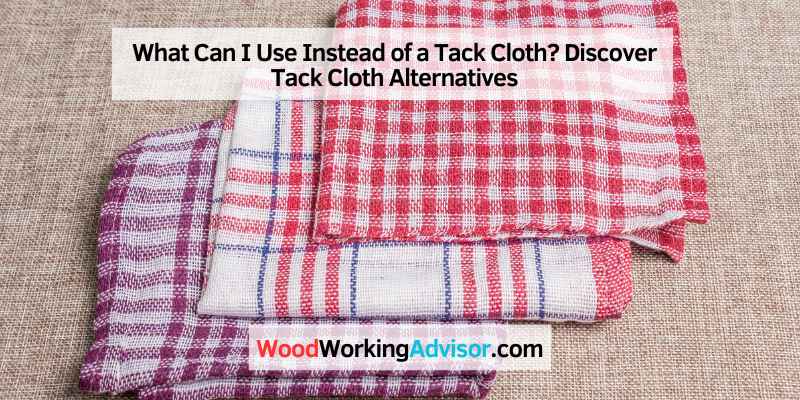Microfiber cloths and cleaning supplies are great alternatives to tack cloth. These options are an excellent choice to remove dirt and dust particles without scratching the surface.
Unlike tack cloth, which has heavy-duty stickiness, microfiber cloths are affordable, lint-free, and can be used and reused many times. They are especially effective when used for woodworking or home improvement projects after sanding between applications of paint or topcoat.
We will explore the various alternatives to tack cloth that you can use for your projects. Whether you’re working on a DIY project or a professional job, it’s essential to have an effective dust removal method that doesn’t damage the surface, and we are here to help you with that.
What Is A Tack Cloth?
Tack cloth is a handy tool used in woodworking and painting for the removal of dust and debris on surfaces prior to painting. Alternatives include microfiber cloths, cleaning sprays, and vacuuming, all of which can effectively remove dirt and particles without leaving residue.
u remove sanding dust without tack cloth? Are there any alternatives to a tack cloth? These are common questions among painters, woodworkers, and DIY enthusiasts. A tack cloth is a sticky cloth used to pick up fine dust, dirt, and debris from surfaces before painting or finishing.
It is made of gauze-like material that is sticky enough to remove particles but not so sticky that it leaves residue on the surface. But what if you don’t have a tack cloth or want to try an alternative? In this article, we will explore the purpose of a tack cloth, how to use it, and some alternatives to try.
Purpose Of A Tack Cloth
The primary purpose of a tack cloth is to pick up loose particles that could potentially ruin your paint or finish. Even after you have vacuumed or wiped a surface, fine dust particles can still remain. These particles can cause “fish eyes” or “cratering” (small holes in the finish) when they mix with the paint or stain. With a tack cloth, you can easily remove these particles without the need for water or solvents.
How To Use A Tack Cloth
Using a tack cloth might seem straightforward, but there are some tips to keep in mind to get the best results. First, make sure your hands are clean and dry before handling a tack cloth. You don’t want to transfer dirt and oils from your hands onto the surface you’re cleaning. Unfold the tack cloth and gently rub it across the surface, making sure to overlap your strokes.
If the surface is large, you will need to fold and refold the tack cloth to expose a clean section. Don’t rub too hard as this could damage the surface. Lastly, discard the tack cloth as soon as it becomes excessively dirty. Reusing a tack cloth can result in transferring debris back onto the surface.
Alternatives To A Tack Cloth
If you don’t have a tack cloth or prefer not to use one, there are alternatives to try. One option is to use a microfiber cloth. They are soft, lint-free, and don’t scratch surfaces. They are also reusable and can be washed in a washing machine. Another alternative is using a lint roller. It’s especially handy for removing pet hair and can be used on fabrics, walls, and ceilings. Finally, you can also use a soft-bristled brush or compressed air to remove particles. These alternatives won’t be as effective as a tack cloth in removing all the debris, but they will still suffice in most cases.
Overall, a tack cloth is a useful tool to have when painting or finishing. But in the absence of a tack cloth, there are alternatives that can produce similar results. These alternatives may require a bit more effort, but they are worth trying out if you don’t have a tack cloth or prefer not to use one. Try out these alternatives and see which one works the best for your project.
Why Use Tack Cloth Alternatives?
Microfiber cloths and cleaning sprays are great alternatives to tack cloth when working on woodworking or home improvement projects. Microfiber cloths such as Trimaco’s Wonder Rags are excellent and lint-free options that won’t scratch your delicate work, and they absorb oil like a sponge.
Plus, they can be used and reused practically indefinitely.

Tack cloth is a sticky piece of cloth that is used to remove any dust or debris that can cause blemishes on paint or stain projects. However, tack cloth may not always be the best option due to its disadvantages, including leaving a sticky residue behind, being only one-time use, and the fact that it may not work well on porous surfaces. Thankfully, there are several alternatives that you can use instead of tack cloth. In this blog post, we will discuss when tack cloth is not necessary and some tack cloth alternatives that you can use for your next project.
When Tack Cloth is Not Necessary
Tack cloth is a useful tool when it comes to removing dust and debris from a surface before painting or staining. However, there are times when tack cloth is not necessary. For instance, if you recently sanded your project surface, then using a tack cloth to clean the surface may not be necessary as the sandpaper already removed most of the debris. Additionally, if you are using a high-quality paint or stain, it may not easily show blemishes caused by dust or debris. In these cases, using a tack cloth may be an unnecessary step.
Tack Cloth Disadvantages
Although tack cloth is a popular option for removing dust, there are some disadvantages to consider. For one, tack cloth is only for one-time use, so if you need to use it multiple times, you’ll end up spending more money. Additionally, tack cloth leaves a sticky residue on the surface, which can be challenging to remove, and may even ruin your project’s finish. Lastly, tack cloth may not work as effectively on porous surfaces, as the adhesive may not be strong enough to remove all the debris.
Tack Cloth Alternatives
Thankfully, there are several tack cloth alternatives that you can use instead. One of the most popular alternatives is a microfiber cloth. Microfiber cloths, such as Trimaco’s Wonder Rags, are lint-free and have soft fibers that are excellent at trapping and holding onto debris without scratching the surface. Another alternative is to use a vacuum cleaner loaded with a fine filter. You can use your vacuum to suck up any debris before applying paint or stain. Lastly, you can also use commercial cleaning sprays and supplies to remove dirt and dust particles effectively.
Conclusion
In conclusion, tack cloth is a useful tool for removing dust and debris from surfaces before painting or staining. However, it’s not always necessary and has some disadvantages, including leaving behind a sticky residue and being only for one-time use. Fortunately, there are several alternatives you can use instead, including microfiber cloths, vacuum cleaners, and commercial cleaning sprays. Choose the option that works best for your project and get ready to enjoy a flawless finish.
Tack Cloth Alternatives
Looking for an alternative to tack cloth? Microfiber cloths like Trimaco’s Wonder Rags are a great lint-free option to remove dirt and dust particles. Cleaning sprays and supplies are also good substitutes to achieve a smooth surface without leaving residue.
If you are working on a project that requires finishing, then you are probably familiar with tack cloth. Tack cloth is a sticky cloth that is used to remove any remaining dust or debris from a surface before finishing. Although tack cloth is an effective tool, it may not always be the most convenient or accessible option. Luckily, there are a few alternatives that you can use instead of tack cloth.
Microfiber Cloth
Microfiber cloths are an excellent alternative to tack cloth. These cloths are effective in removing fine dust created when sanding between paint applications or finishes. They are lint-free and won’t scratch the surface. The soft fibers trap and hold particles within, making them ideal for gentle cleaning.
Vacuuming Before Finishing
If you do not have microfiber cloths or tack cloth readily available, you can use your vacuum to remove dust before finishing. Vacuuming works by removing dust particles from the surface, so they do not end up in the air and then land back onto the surface. Avoid using a brush attachment as it may scratch the surface of the project.
Cheese Cloth
Another alternative to a tack cloth is a cheesecloth. A cheesecloth is a versatile kitchen tool, which can also be used to clean and wipe surfaces. Although it may not be as effective as tack cloth or microfiber cloth in trapping dust and debris, it can still be useful in some situations.
Cleaning Sprays
Cleaning sprays can also be used in place of a tack cloth. These sprays are designed to remove dust and dirt particles from surfaces without leaving any residue. They come in various forms, including aerosol sprays and pump sprays. It is essential to choose a cleaning product that is safe for the surface you are working on, as some cleaning sprays can damage finishes.
In conclusion, these are some of the alternatives that you can use instead of tack cloth. Microfiber cloths, vacuuming, cheese cloth, and cleaning sprays are excellent substitutes for tack cloth. Choose the one that works best for your project or needs. A clean surface is essential when finishing or painting, and using any of these alternatives will help you achieve the desired results.
How To Make Homemade Tack Cloth
If you’re looking for an alternative to a tack cloth, try using microfiber cloths or cleaning sprays and supplies to remove dirt and dust particles. You can even make your own homemade tack cloth by using a lint-free cloth and applying a small amount of varnish or paint thinner.
Microfiber cloths are an excellent and inexpensive option, that won’t scratch the surface.
Using Cheese Cloth
If you don’t have a tack cloth on hand but need to remove sawdust and other debris from your project before painting or staining it, you can make your own tack cloth using cheesecloth. Here’s how to do it:
- First, gather your supplies. You’ll need cheesecloth, which can be purchased at most craft and fabric stores, and a small amount of mineral spirits or turpentine.
- Cut a piece of cheesecloth to the size you need. A good rule of thumb is to use a piece that will fit comfortably in your hand.
- Fold the cheesecloth in half so that it’s two layers thick.
- Saturate the cheesecloth with a small amount of mineral spirits or turpentine. You don’t want it to be soaking wet, but you do want it to be damp.
- Squeeze out any excess liquid and use the cheesecloth to wipe down your project.
- Repeat the process as necessary, using a fresh piece of cheesecloth if the first one becomes too dirty or saturated.
Using Microfiber Cloth
If you don’t have cheesecloth on hand, a microfiber cloth can be an effective substitute for a tack cloth. Here’s how to use a microfiber cloth to remove sawdust and other debris from your project before painting or staining it:
- First, gather your supplies. You’ll need a microfiber cloth, which can be purchased at most hardware stores or online.
- Make sure the cloth is clean and dry before you start.
- Use the microfiber cloth to wipe down your project, making sure to remove any sawdust or debris that may have accumulated.
- If the cloth becomes too dirty or saturated, simply switch to a fresh one.
- When you’re finished wiping down your project, dispose of the microfiber cloth or wash it according to the manufacturer’s instructions.
In Conclusion
While a tack cloth is a handy tool to have in your arsenal of painting and woodworking supplies, it’s not always necessary. In a pinch, you can make your own tack cloth using cheesecloth and mineral spirits or use a microfiber cloth to achieve similar results. Whatever method you choose, make sure to thoroughly clean your project before applying any paint or stain to ensure a smooth and flawless finish.
Substitutes For Tack It
Loctite and microfiber cloths are great substitutes for tack cloth when it comes to home improvement or woodworking projects, as they effectively remove dirt and dust particles without leaving any residue or scratching surfaces. Trimaco’s Wonder Rags are also a good option as they are lint-free and relatively inexpensive.
Tack It is a popular product used in woodworking and painting as it picks up dust and debris from surfaces. However, there are alternatives to Tack It that can be just as effective and cost-effective. In this article, we will discuss using Loctite as a substitute for Tack It and other options you can use instead.
Using Loctite
Loctite is a brand that produces adhesive products, and one of their products can be used as a substitute for Tack It. Loctite’s temporary adhesive is a spray adhesive that can be used to remove dust and debris from surfaces. Spray the adhesive onto a clean cloth or rag and wipe the surface gently. The adhesive will pick up the dust and debris, leaving a clean surface.
Loctite’s adhesive is easy to use and doesn’t leave a residue, making it a great alternative to Tack It. Moreover, it is readily available at most hardware stores and is affordable.
Other alternatives to Tack It include microfiber cloths and cleaning sprays. Microfiber cloths are an excellent option for removing dust and debris, and they are reusable, making them a cost-effective solution. Cleaning sprays are another option, and they can be used to clean surfaces without leaving a sticky residue.
In conclusion, Tack It is not the only product that can remove dust and debris from surfaces. Using Loctite, microfiber cloths, and cleaning sprays are excellent, cost-effective alternatives to Tack It. These products are readily available in stores and easy to use, giving you a clean surface without breaking the bank on expensive products.

Frequently Asked Questions On What Can I Use Instead Of A Tack Cloth
How Do You Make A Homemade Tack Cloth?
To make a homemade tack cloth, you can use microfiber cloths that are soft with split fibers to trap and hold particles. These cloths are effective in removing wood dust after sanding and don’t scratch the surface. Additionally, cleaning sprays and supplies can also be used to remove dust particles.
Alternatively, you can use cheese cloth for removing fine dust before finishing.
How Do You Remove Sanding Dust Without Tack Cloth?
Microfiber cloths can be used instead of tack cloth to remove sanding dust. These cloths are effective at trapping and holding fine particles without scratching the surface. Alternatively, cleaning sprays or a clean cloth rag with alcohol can also be used for dust removal.
Avoid using water as it may not effectively remove dust particles.
What Can You Use Instead Of Tack It?
Microfiber cloths and cleaning sprays are excellent alternatives to tack cloth. They are lint-free, do not scratch delicate surfaces, and absorb oil like a sponge. Vacuuming followed by wiping with a clean cloth rag and either alcohol or mineral spirits can also replace the use of tack cloth.
Cheese cloth is recommended for removing fine dust before finishing. Loctite can also be used instead of tack it.
Is Microfiber As Good As Tack Cloth?
Microfiber cloths are an excellent alternative to tack cloth. These are lint-free, soft, and traps and holds particles within their split fibers without scratching the surface. They work just as effectively in removing the fine dust created when sanding between applications of paint or topcoat.
Additionally, cleaning sprays and supplies are also great alternatives in removing dirt and dust particles.
Conclusion
There are several alternatives to a tack cloth that can be just as effective without the sticky residue. Microfiber cloths, like Trimaco’s Wonder Rags, are excellent, lint-free options that won’t scratch or leave particles on your surface. Cleaning sprays and supplies can also be used to remove dirt and dust particles.
Cheese cloth and a clean cloth rag with mineral spirits or alcohol are also good substitutes. By trying out these alternatives, you can find the best method for your specific project and achieve professional results.


